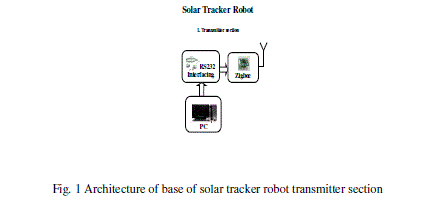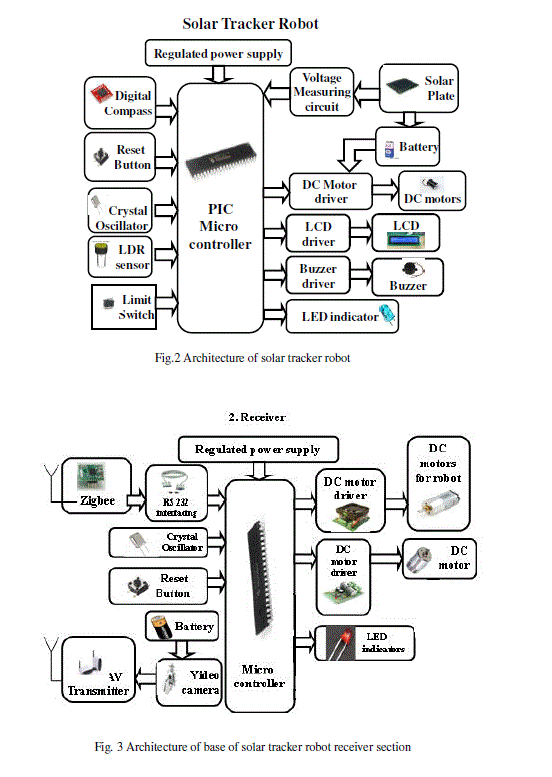ISSN ONLINE(2278-8875) PRINT (2320-3765)
ISSN ONLINE(2278-8875) PRINT (2320-3765)
| B.Suchitha Samuel1, J.Mrudula2 |
| Related article at Pubmed, Scholar Google |
Visit for more related articles at International Journal of Advanced Research in Electrical, Electronics and Instrumentation Engineering
Surveillance is increasingly becoming one of the most important subjects when it comes to security. In this work I have aimed to design a portable, economically viable alternative to manual surveillance that can find application in both civilian and military sectors. In this paper I have attempted to utilize the solar power for operation of robot for surveillance with an intelligent feedback .As powering the robots for surveillance is difficult this project provides a solar powered mobile microcontroller based surveillance platform which is an amicable solution to the problem. The project involves a PIC microcontroller, digital compass, H-bridge drivers and a automatic solar tracker setup. The functioning of the solar tracking system is independent of the robot movement. The project can be used as a multipurpose surveillance platform in both household and war field applications.
Keywords |
| Surveillance, PIC Microcontroller, LDR Sensors, H-Bridge Driver, solar panel, Digital Compass |
INTRODUCTION |
| It is often observed that it is difficult to carry out manual surveillance in various scenarios where either the conditions are hostile for sending in personnel (fires, hostage situation) [6] or the available man power is insufficient to dispatch workforce at our disposal (patrolling large complexes) [9].Also the recharging of robots in warfield or surveillance robots in far off locations often becomes problematic. In these situations it becomes imperative to have a platform that can negotiate these difficulties while still remaining economically viable. A mobile microcontroller based surveillance platform is one such option. |
| Solar tracking for robot/vehicles is mostly done using fixed solar panels which is disadvantageous. This paper presents the hardware design and implementation of a system which performs intelligent solar tracking and powering the robot with solar energy that can be used for surveillance and monitoring operations .This paper aims to present a microcontroller based surveillance platform that is effective as a surveillance tool in both civilian and military applications. The main aim of our project is to make the panel to rotate according to the sun’s direction from morning to evening automatically so that the panel grabs the solar energy to maximum extent possible throughout the day. Intelligent Solar Tracking System is used to generate power from sunlight and it can be used by storing the generated power. This method of power generation is simple and is taken from natural resource. |
II. BACKGROUND OF RELATED WORK |
| As of now there are many projects related to solar tracking system that are proposed to improve it such as the Microprocessor Based Solar Tracking System Using Stepper Motor where the microprocessor is being used to control the tracking system by interfacing with others components. However, it requires external components to implement program memory [4]. A Miniature Solar Tracker was built which is microcontroller based and single- axis tracking system using DC motor. This project is simple, since the tracking system is supported by a tripod [5]. Mobile Robots for Outdoor Security Applications was built to provide multiple mobile platforms performing random patrols in warehouses and storage sites, both indoor and in semi-structured outdoor environments [7]. |
III. METHODOLOGY |
| The unique feature of the proposed system is that instead of taking the earth as its reference, it takes the sun as a guiding source. Its active sensors constantly monitor the sunlight and rotate the panel towards the direction where the intensity of sunlight is maximum from morning to evening automatically, so that the panel grabs the solar energy to maximum extent possible throughout the day [2]. When there is decrease in intensity of l ight, this system automat ical ly changes its direction to get maximum intensity of light. The power generated from this process is then stored in a bat tery. The controlling device of the whole system is a PIC Microcontroller .The light dependent resistors do the job of sensing the change in the position of the sun which is dealt by the respective change in the solar panel’s position by switching on and off the geared motor. The voltage from solar panels will be displayed on LCD by interfacing solar panel to PIC microcontroller through a voltage measuring circuitry. |
| The objectives of the project include: |
| 1. Wireless controlling of robot through PC using Zigbee technology |
| 2. Live Audio and video can be seen on TV |
| 3. Powering of robot using solar energy |
| 4. Independent tracker movement with respect to robot |
| This robot/vehicle is designed in such a way that there is no requirement of manual attention towards it. It makes use of the Digital compass to move the Robot in that direction. When the robot system moves in wrong direction with respect to the solar tracker it alerts through buzzer alarm system. Limit switches are provided at the east and west limits to prevent the complete rotation of the solar tracker. LED’s are provided as indicators for solar panel extreme limit rotations. In the controller part, it consists of PIC16F877A chip, DC motors interfaced to the robot, and LED’s for display. H-Bridge drivers are used in order to tolerate changing power requirements In many situations it is advantageous to have the robot tele-operated.The remote control signals can be sent through a wire, through a local wireless system (like Wi-Fi), over the Internet or by satellite[1].The remote monitoring capabilities can also be enhanced by using the wireless network[8]. The robot can be moved in all the directions using the Zigbee module interfaced to PC wirelessly. The live images from the camera in the robot system can be sent to TV through AV system. The microcontrollers used in the project are programmed using Embedded C language. |
| A. System Architecture |
| Whole system includes light sensors, digital compass, limit switches, four DC motors, and H-Bridge motor drivers. Two major parts, from the figure are tracker and the base. The PIC16F877A microcontroller on the control circuit is the main processor which will control the whole system. |
 |
 |
| B. Hardware Description |
| 1) LDR Sensors: To detect the present of sunlight we have used LDR sensors. LDR is a special type of resistance whose value depends on the brightness of the light, which is falling on it. It has resistance of about 1 mega ohm when in total darkness, but a resistance of only about 5k ohms when brightness illuminated. When west cell (W) is in shadow, tracker rotates to east, while when east cell (E) in shadow, tracker will rotate to west [3]. |
| 2) Solar Panel: A solar cell or photovoltaic cell is a device that converts solar energy into electricity by the photovoltaic effect. The collection of solar cells is called a solar panel or solar array. Solar panel is placed on top of the tracker board which absorbs the maximum sunlight which is used as supply to the motors or stored in the battery for future use. |
| 3) Digital Compass (HMC6352): The HMC6352 is a fully integrated compass module that combines 2-axis magnetoresistive sensors with the required analog and digital support circuits, and algorithms for heading computation. The HMC6352 communicates via a two-wire I2C bus system as a slave device. The digital compass provides the feedback to the robot with respect to the tracker. |
| 4) Microcontroller (PIC16F877A): PIC16F877A from Microchip is a single microcontroller which is very easy to be assembled, programmed and also the price is very cheap. One unit of PIC16F877A microcontroller can be programmed and erased so many times.PIC includes features for entire analog as well as digital form of operations. Two PIC microcontrollers are used in the project. It plays a major role as the coordination between different components in the circuit is maintained by the microcontroller |
| 5) Zigbee: Zigbee is a wireless technology developed as an open global standard to address the unique needs of lowcost, low-power, wireless sensor networks. This network is one of the widely used open source wireless network available in the market. In the project we use Zigbee (RF Transceiver). The PC provides the information to the Zigbee module. The Zigbee at the robot receives the command and microcontroller (on board computer) controls the direction respectively. |
| 6) DC Motors: A DC Motor is a mechanically commutated electric motor powered from direct current (DC). Modern DC motors are often controlled by power electronics systems called DC drives. H-Bridge circuits are often used in robotics and other applications to allow DC motors to run forwards and backwards. H bridges are available as integrated circuits, or can be built from components. The H-bridge arrangement is generally used to reverse the polarity of the motor. |
| 7) Wireless Camera: The camera is with 1.2GHZ, with Audio and CMOS and receiver unit with manual frequency adjustment. The linear transmission distance is 50-100m and the transmission and receiving signals are in the form of both audio and video. |
IV. RESULTS |
| The project designed with the solar powered robot/vehicle with tracker set up using DC motor; limit switch and LDR sensors was controlled successfully using the PC. The robot was placed in the sunlight since morning to evening and the tracker could track the maximum sunlight. The power obtained through it was used to operate the robot from a far off location and monitor the surroundings according to the commands given through the PC. Live audio and video information was received efficiently |
V. CONCLUSION |
| Based on the results, the objective of developing the project has been achieved. Integrating features of all the hardware components used have been developed in it. Presence of every module has been reasoned out and placed carefully, thus contributing to the best working of the unit. Secondly, using highly advanced IC’s with the help of growing technology, the project has been successfully implemented. The project demonstrated that implementing solar tracking on mobile robots can be done successfully and can be controlled actively from far off locations for monitoring applications. Thus the project has been successfully designed and tested. |
VI. FUTURE SCOPE AND RECOMMENDATIONS |
| In future we can use this project in several applications by adding additional components to it. Further, the use of sensors provides a new dimension to the robot and increases the scope of its application .The project can be extended by using sensors which detects any leakage of LPG gas, smoke or any fire and alerts the user through alarm. It can be used for warfield and monitoring applications in far off areas. The solar tracking robot involves wired connections which makes it water sensitive. It can be made more powerful by more mechanical advancements. |
ACKNOWLEDGEMENT |
| I extend my sincere thanks to the Head and all the faculty members of our department for giving me the technical assistance for carrying out the study. My truthful appreciation is to my co-author who has helped me in preparing this paper |
References |
|